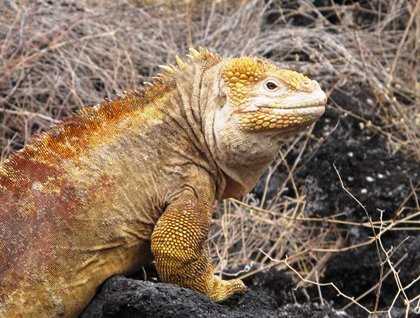We were wrong to think that we had already lived the best experiences during these days in the Galapagos Islands. Today was yet another spectacular day… We have seen so many wonderful creatures in this remote archipelago. After breakfast, we set foot on Isabela Island for the first time in order to visit Urbina Bay. Its coast looks uninviting, dominated by jagged lavas known as Aa. Some sixty years ago this area was submerged under the sea, but a sudden volcanic event uplifted this stretch of coast, taking living marine creatures like corals, sea turtles and lobsters with it. Nowadays, a circular trail takes us from the coast further inland. There are large areas of both sand and soft pumice and compacted volcanic ash, and together with the abundant vegetation they provide the perfect habitat for the land iguanas. These attractive, endemic species feed on leaves, fruit and flowers, and are able to withstand long shortages of fresh water. In recent times, a small population of giant tortoises have made the Urbina Bay area their home, and today was not an exception, we were fortunate to have encountered several of them on or near the trail. Some were small in size, others medium and a large giant tortoise was there too! We feel that these are the survivors of a long era when they used to be hunted by humans for food and as a source of oil. After the walk we returned to the landing beach where some of us went for a quick dip in the water, which felt super pleasant!
After weighing anchor we navigated further north along this western coast of Isabela Island. This coastline is quite stunning with its many tuff cones, craters and black lava flows that end in the sea. The sky was blue, and so was the sea. In the distance we spotted sea birds flying in circles above the water, and as we got closer we realized what they were up to: they were eating the scraps left by a small pod of hunting killer whales. It was hard to believe that in just a day we had seen a couple of the most amazing whales on earth!
After stopping briefly to takes photos of this amazing event we continued and finally dropped anchor at Tagus Cove. Since the early 1800s this place has been visited by many ships, as it offers a safe anchorage and occasionally there is fresh water in the vicinity. Many sailors carved or painted the name of their vessel and the year of visit, a tradition that is no longer allowed by the Galapagos National Park Service. Tagus Cove is located between two massive tuff cones, and the coastline is simply gorgeous. Here one can find Galapagos penguins, flightless cormorants, pelicans and blue-footed boobies, as well as sea lions, sea turtles and many other marine creatures. The geological formations are breathtaking, so a hike to a small summit further inland was a must. From here, there are great views of the nearby craters and volcanoes of both Isabela and Fernandina Islands. Upon our return to the National Geographic Islander, the sun was setting, spreading its beautiful pink and orange light. Today we felt that these islands are real treasures and we are more than fortunate to be here.







